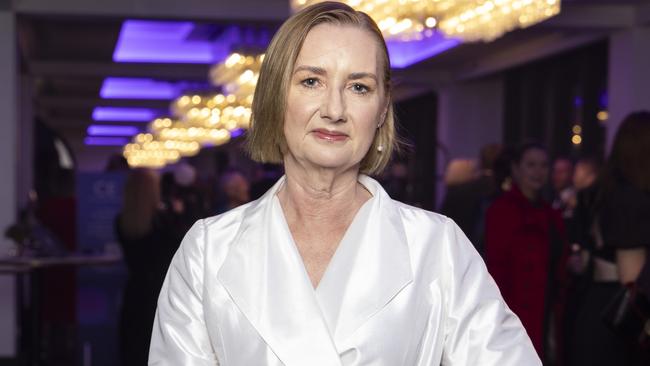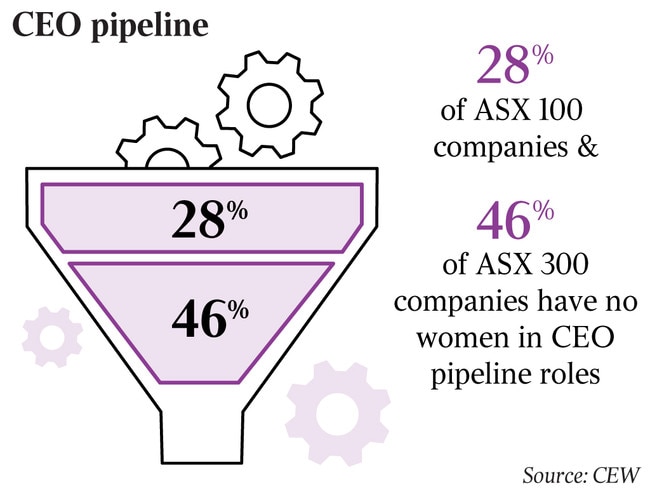Corporates hit the wall on women CEOs in ASX300: CEW survey
The latest CEW survey finds that progress for women at the top has stalled with a fall in the number of female chief executives in the ASX300.

Gender equity in Australia’s top companies has taken a hit as tough economic times stall the interest in appointing women to the top jobs.
The number of females CEOs in the ASX 300 fell in 2024, a backwards step described as “alarming” by the peak advocacy body, Chief Executive Women.
Releasing its annual senior executive census on Tuesday, CEW president Susan Lloyd-Hurwitz said the fall – from 26 female CEOs in 2023 to 25 this year – was the second drop in eight years, with the first during the Covid-19 period.
“When it comes to leadership in corporate Australia, we are leaving some of our best talent on the bench,” she said. “The sector has talked the talk on gender equality for years, but the numbers tell a different story – one of regression, not progression.”
She blamed the stagnation on a lack of commitment to gender equity programs and policies in a “challenging economic and cultural environment”.
The alarming findings reveal that 91 per cent of CEO positions are still held by men.
Equally dire is that women are being appointed CEOs of ASX 300 companies at a slower rate to men – one in eight, compared to one in four last year.
The pipeline – which provides candidates for the limited top jobs – is also in a bad way. And the report suggests progress is unlikely because “82 per cent of CEO pipeline roles are filled by men, and an increasing number of companies have no women leaders in pipeline roles”. But Ms Lloyd-Hurwitz warned that talent pipelines “are critical tools, but they’re not a silver bullet, they’re structural solutions that require accountability, transparency and strong leadership”.
She urged companies to do more and set real gender targets.
Referencing the “challenging cultural environment”, Ms Lloyd-Hurwitz said: “We must remember that diverse voices are important and diverse leadership teams are good for business. “While the overall picture is a gloomy one, there are green shoots in some areas – some businesses have accelerated their gender balanced leadership and gender equality across the company. We know from these companies what works.”
The census report finds some improvement – 27 per cent of ASX 300 companies have achieved gender-balanced Executive Leadership Teams; and the number of companies with no women in their ELTs has decreased to 20.
Ms Lloyd-Hurwitz said Australia had one of the most highly gender-segregated workforces in the OECD.
“Research, both in Australia and internationally, has found that companies with diverse leadership teams perform better,” she said. “CEW advocates for a ‘40:40:20 by 2030’ gender target, which could unlock substantial economic growth and productivity. But the time for action is now.”
The CEW census shows the top 100 companies in the ASX have a better representation of women at the senior level than their ASX 101-300 counterparts, and are also more likely to have set gender targets.

Despite a 4 per cent increase in the number of gender-balanced ELTs, seven out of 10 ELT roles are still held by men. The census found 70 per cent of women in ASX 300 ELTs were working in non-pipeline roles, meaning they were unlikely to be considered for promotion to CEO; and 46 per cent of ASX 300 companies have no women in these critical feeder roles.
The report calls for a re-evaluation of the traditional pathways to CEO roles, “which are often limited to those who drive key commercial outcomes with profit and loss (P&L) responsibility”.
“Research by Seramount shows men are three times more likely to be encouraged to consider a P&L role than women, and nearly half the men surveyed reported receiving detailed advice at work on how to chart their path to such a role, compared with 15 per cent of women,” the report says.
“By broadening the criteria to include roles such as human resources, strategy and marketing, companies can future fit their leadership teams while also delivering a gender diversity dividend.”
“Leadership is about more than just managing a P&L,” Ms Lloyd-Hurwitz said. “It’s time we expanded our definition of what makes a successful CEO to include a broader range of skills and experiences.”
The census calls for further investment in gender-balanced executive pipelines, with sponsorship by male leaders seen as a critical lever for change.
“High-potential women who are sponsored, specifically by senior male leaders, are 20 per cent more likely to be promoted, yet they remain half as likely as men to have such sponsors.”




